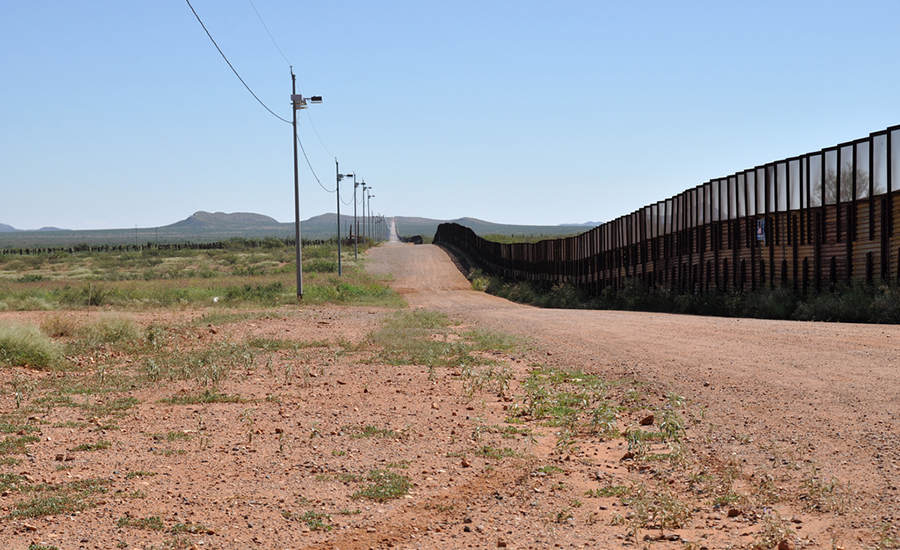In the following op-ed, Yale School of Architecture professor Peggy Deamer and students David Langdon and Melinda Agron call on architects to express their ethical convictions through their work.
In the aftermath of the 2016 election, the American Institute of Architects issued an incendiary statement of congratulations and support for the yet-unknown infrastructure agenda of the Trump administration. The recoil from the architecture community was loud and swift. Architects, students, and community members publicly denounced what they saw as a greedy and spineless compromise of professional responsibilities, and #NotMyAIA began trending on Twitter. Within days, AIA CEO Robert Ivy rescinded the organization’s statement and apologized.
Flash forward to two weeks ago, when President Trump issued a preliminary RFP—request for proposals—for design prototypes of the long-promised border wall. In the hours and days that followed, dozens of prominent architecture and engineering firms threw their hats in for a chance at the multi-billion-dollar project. The concerns that architects voiced in November of professional collusion with the administration’s partisan agenda proved dishearteningly prescient and well-founded.
For many of us, both the AIA statement and the responses to the RFP reflect a profession that has become passive about its ethical mission. As traditional models of practice lose influence and market share to computer technologies and peer industries, the response among architects has generally been to underbid desperately-needed jobs. But this cycle doesn’t just devalue architectural labor and our much-needed offerings; it disempowers our profession to the point where it can no longer assert moral agency. Collectively, we have failed to enact policies that would bar architects from designing places of execution or solitary confinement. We've rarely used our influence to dissuade overseas contractors from "employing" indentured construction workers. Particularly at a time when infrastructure seems to threaten more harm than good, our profession has failed in its task to show the public that we are more than ambulance chasers.
The invitation to participate in the border wall strikes a particularly sensitive nerve. Historically, architecture has willingly complied with political schemes that discriminate against marginalized communities and concretize systemic inequalities. During World War II, American architects participated in the design of Japanese internment camps. In the federal highway projects that followed, architects and engineers participated in the design of new infrastructure that invidiously targeted minority communities for “slum” clearance. Architects ignored the fact that housing we designed filled the pockets of developers breaking anti-discrimination laws. Today, we contribute designs to Olympic developments that drain nations’ resources and we undertake unrealistic projects with public funding, like the World Trade Center Transportation Hub, that prove impossible to complete on time and within a reasonable budget.
Architecture is fundamentally a political and social act, and capitulation to opportunism will only precipitate further loss of identity and potential. The act of designing and building our physical landscape comes with significant responsibilities. Architecture foremost must improve the lives of the people it serves, and it must be active in creating environments that promote justice and equal opportunity. It should dismantle social barriers rather than erect them. It must also take seriously the stewardship of human and natural resources, and decry wasteful and harmful political stunts in the face of real needs.
With President Trump, on-the-ground professionals have been handed the starkest wakeup call. It is up to each of us to individually express our ethical convictions and use our skills to assert leadership where it is needed. At an institutional level, our professional organizations, which include the AIA, must begin to lead rather than plead for unethical work.
The Architecture Lobby—a forward-thinking alternative to the AIA organized in 2013 by a collective of students, practitioners, and academics—has proposed that March 10, the day the first round of border wall proposals are due, cannot witness business as usual. We emphatically agree. It should be a day given over to debate. At each firm, and within each academic setting, it should be a day for challenging and affirming our definitions of what it means to be an architect. It should be a day for writing our congressmen and women to share our understanding of infrastructure as both physical and social. And it should be a day for digesting the meaning and obligation of architecture, not just producing it.
The border wall is only the latest demonstration of how architecture’s power and vision is so important, but it will not be the last. We hope that on March 10, an internal pause and reset can restore our sense of purpose.
Peggy Deamer, Professor, Yale School of Architecture
David Langdon, M.Arch I Candidate, Yale School of Architecture
Melinda Agron, M.Arch I/M.B.A. Candidate, Yale School of Architecture




Post a comment to this article
Report Abusive Comment